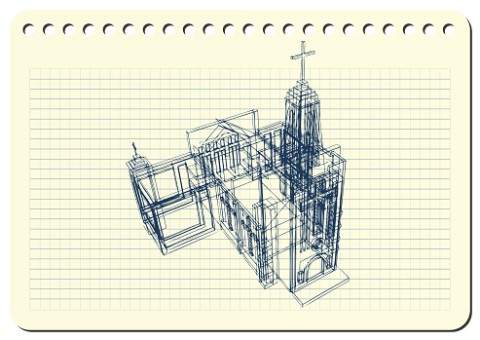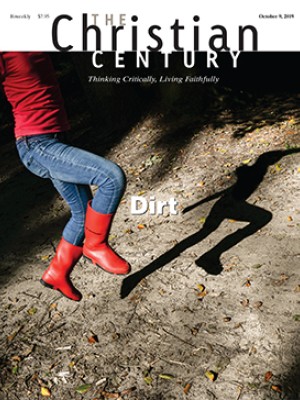When the chapel is the most open place on campus
Virginia Woolf’s ideal university had no chapel. Mine has more than one.

The main building of my school is closed for renovation. I’ve worked in offices inside of it for almost 20 years, worshiped in its chapel, taught in its classrooms, and sat in more faculty meetings than I’d care to count within its walls. I like its churchy feel—there are pews in the hallways and leaded glass windows—but it needs more light, more places to gather, smarter classrooms, and more worship spaces usable by more religious communities. When it finally emerges from its cocoon of scaffolding and boarded-up windows, it will have all of these things and a new name as well. Its rebirth will mark a new beginning for us, a new chance to create the school of our dreams.
The dream of the ideal school has been cherished by educators for centuries. One of my favorite such visions comes from the writer Virginia Woolf. In 1938, as fascism gained strength in Europe, Woolf—in her book Three Guineas—imagined a school that would be experimental at its core, focused not on specialization but on seeking new combinations of ideas and practices that would support human flourishing and creativity. It would be a school that would form people who hate war.
Read our latest issue or browse back issues.
What would such a school need? Woolf believed it would need the perspective of those who have been excluded from the universities because of their gender, race, or religion—because only they would have the freedom to see beyond the status quo. It would need a faculty drawn not only from the good thinkers but also from the “good livers.” It would need art made by a new generation. It would need a curriculum focused not on the accumulation of wealth and power but on those arts, from mathematics and medicine to music and literature, that teach us to cherish what it is to be human and alive in the world.
What Woolf’s ideal university did not require, interestingly, was a nice building. She imagined a college made from cheap materials around which neither dust nor traditions would collect. There would be no carved stone, no stained glass, no books behind lock and key, no uniforms or ceremonies. The tyrants have hypnotized Europe with their pageantry, Woolf wrote, so we need to see beyond our own pageants and focus instead on respect for one another’s humanity, the cultivation of imagination about others’ lives and minds, the ways in which new forms of community might be encouraged through food and talk and art making and study.
One feature of Woolf’s ideal college that was nonnegotiable for her was this: that there be no chapels. She distrusted public rituals, religious or political, because they were so often used to keep gender hierarchies in place and dictatorships in power. Her ideal college would be free of such rituals and the chapels in which they were performed.
I’m ministering in my own university’s chapel this year, and I’ve been thinking that, even though she disapproved of such places, her vision for the ideal school would make a powerful vision for university chapels as well. Woolf distrusted public rituals but was drawn to the more intimate ones that take shape around dinner tables or find expression in village plays, rituals that can turn a woman’s ordinary movements through her day into a kind of pilgrimage. Woolf’s vision challenges us to reflect on our own rituals, our own practices. Do they offer multiple doors for people to enter? Do they illuminate the sacred in the world around us and in our encounters with one another?
At their best, university chapels are experimental spaces, places where people sift through narrative and poetry, music and ritual, history and practice to create from new combinations of old things something that is alive in the present. They offer a place to put the specialized knowledge of the university into conversation with larger human concerns; to consider the wisdom of religious thought and practice as part of our human inheritance; and to ask what we might learn through prayer, faith, and service. Chapels have the potential to be the most open places on campus: even in universities to which it is difficult to gain admission, the life of the chapel is open to everyone. Instead of no chapels, maybe what we need is more chapels: more points of entry into the university and its resources, more places to experiment with new combinations, more opportunities to practice with others being the “good livers” we aspire to be.
The human longing for peace and freedom, Woolf wrote at the end of Three Guineas, depends upon “the capacity of the human spirit to overflow boundaries.” This is also where education leads in another vision of the ideal school—St. Benedict’s rule for monasteries. Benedict imagined the monastery as a “school for the Lord’s service” whose way of life leads to “hearts overflowing with the inexpressible delight of love.” If we can overflow the boundaries within us and around us, then things do not have to be as they are. No matter the materials from which it is made, no matter how “smart” (or not) its classrooms, the ideal school (like the ideal chapel) is the one that helps us resist calls to harden our borders and our hearts, allows us to feel the claim of the lives of others on our own, and makes room for our hearts and lives to overflow.
A version of this article appears in the print edition under the title “A chapel with open doors.”







